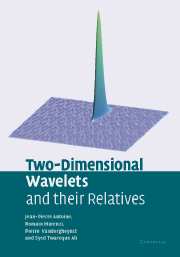Book contents
- Frontmatter
- Contents
- Prologue
- 1 Warm-up: the 1-D continuous wavelet transform
- 2 The 2-D continuous wavelet transform
- 3 Some 2-D wavelets and their performance
- 4 Applications of the 2-D CWT. I: image processing
- 5 Applications of the 2-D CWT. II: physical applications
- 6 Matrix geometry of wavelet analysis. I
- 7 Matrix geometry of wavelet analysis. II
- 8 Minimal uncertainty and Wigner transforms
- 9 Higher-dimensional wavelets
- 10 Spatio-temporal wavelets and motion estimation
- 11 Beyond wavelets
- Epilogue
- Appendix: Some elements of group theory
- References
- Index
10 - Spatio-temporal wavelets and motion estimation
Published online by Cambridge University Press: 19 August 2009
- Frontmatter
- Contents
- Prologue
- 1 Warm-up: the 1-D continuous wavelet transform
- 2 The 2-D continuous wavelet transform
- 3 Some 2-D wavelets and their performance
- 4 Applications of the 2-D CWT. I: image processing
- 5 Applications of the 2-D CWT. II: physical applications
- 6 Matrix geometry of wavelet analysis. I
- 7 Matrix geometry of wavelet analysis. II
- 8 Minimal uncertainty and Wigner transforms
- 9 Higher-dimensional wavelets
- 10 Spatio-temporal wavelets and motion estimation
- 11 Beyond wavelets
- Epilogue
- Appendix: Some elements of group theory
- References
- Index
Summary
Introduction
We live in a world where objects (cars, animals, men, birds, aeroplanes, the Sun, etc.) that surround us are constantly in relative motion. One would like to extract the motion information from the observation of the scene and use it for various purposes, such as detection, tracking and identification. In particular, tracking of multiple objects is of great importance in many real world scenarios. The examples include traffic monitoring, autonomous vehicle navigation, and tracking of ballistic missile warheads. Tracking is a complex problem, often requiring to estimate motion parameters – such as position, velocity – under very challenging situations. Algorithms of this type typically have difficulty in the presence of noise, when the object is obscured, in situations including crossing trajectories, and when highly maneuvering objects are present.
Most motion estimation (ME) techniques such as the ones based on block matching, optical flow, and phase difference [Jah97,280,281] assume that the object is constant from frame to frame. That is, the signature of the object does not change with time. Consequently, these techniques tend to have difficulty handling complex motion, particularly when noise is present.
The time-dependent continuous wavelet transform (CWT) is attractive as a tool for analysis, in that important motion parameters can be compactly and clearly represented.
Information
- Type
- Chapter
- Information
- Two-Dimensional Wavelets and their Relatives , pp. 343 - 372Publisher: Cambridge University PressPrint publication year: 2004
